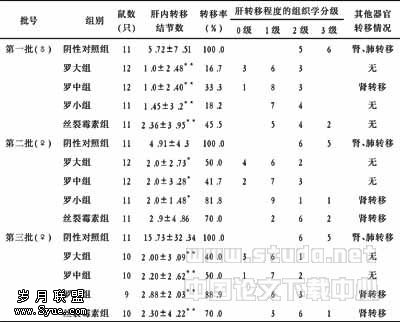5 km高空缺氧对小鼠肝脾及血清中Zn ,Cu和Fe的影响
【摘要】 目的: 探讨5 km高空缺氧和不缺氧对小鼠肝、脾及血清中Zn, Cu, Fe的影响. 方法: 高空缺氧试验:将雄性昆明种小鼠20只,随机分为实验组(5 km高空缺氧30 min组)和地面对照组,每组10只. 将实验组小鼠置于低压舱内,以40 m/s的速度上升到5 km,停留30 min后,以40 m/s速度降至地面;地面对照组放置在另一低压舱中留在地面. 连续7 d后,抽取小鼠静脉血液并处死小鼠取肝、脾. 高空不缺氧试验:分组及实验方法同上. 舱内压力为54.02 kPa,其中氧分压为21.2 kPa. 舱内容积百分比为41.8%氧和58.2%氮的混合气体. 用测氧仪监测舱内氧压,保持其肺泡氧分压与地面相同. 采用火焰原子吸收法测定血清Zn,Cu和Fe的含量. 结果: 5 km 高空缺氧组与对照组相比较,小鼠肝中Cu和Fe含量均显著降低,差异有统计学意义(P<0.05);脾中Fe的含量明显升高,差异有统计学意义(P<0.05);两组血清中Zn,Cu和Fe含量均无明显变化,差异无统计学意义(P>0.05). 5 km 高空不缺氧组与对照组相比较,小鼠肝、脾中Zn,Cu和Fe含量均降低,差异具有统计学意义(P<0.05),血清中Zn,Cu和Fe含量均无明显变化,差异无统计学意义(P>0.05). 结论: 5 km高空缺氧时对小鼠肝中Cu和Fe的合成产生影响;5 km高空缺氧和不缺氧时小鼠血清中Zn,Cu和Fe的含量无明显变化,表明其含量可能与机体缺氧无关.
【关键词】 高海拔缺氧;肝;脾;血清;锌;铜;铁
【Abstract】 AIM: To explore the influence of 5 km altitude hypoxia and anoxia on Zn, Cu, Fe in mouse liver, spleen and serum. METHODS: Experiment 1: 20 male mice were divided into experimental and control group randomly(n=10). The experimental group was put into low?pressure module and ascended to 5 km altitude at the speed of 40 m/s and stayed for 30 min, then descended to the ground at the same speed. The control one was put into another low?pressure module on the ground, successively for 7 d, and then the mice were killed and livers, spleens and sera were taken. The contents of Zn, Cu and Fe were determined by the method of flame atom absorption. Experiment 2: The grouping and maneuvers were the same with the above experiment except that the pressure in the module was kept 54.02 kPa in total pressure and 21.2 kPa in partial pressure and the mixed gas comprised 41.8% oxygen and 58.2% nitrogen. The alveolar oxygen partial pressure was monitored by oxygen analyzer in module to keep the same with the one at ground. RESULTS: In experiment 1, compared with control group, the contents of Cu and Fe in liver were significantly decreased (P<0.05) and the Fe content in spleen was significantly increased (P<0.05) in the experimental group; the contents of Zn, Cu and Fe in both groups were not significantly different (P>0.05). In experiment 2, compared with control group, the contents of Zn, Cu and Fe were descended significantly in experimental group (P<0.05), while the alterations in the sera of experimental group were not significant statistically (P>0.05). CONCLUSION: 5 km altitude?induced hypoxia effects the production of Cu and Fe in mouse liver. The sera contents of Zn, Cu and Fe do not change at 5 km high altitude in both normal and anoxia mice, which indicates the contents are not correlated with the hypoxia.
【Keywords】 altitude; anoxia; liver; spleen; serum; Zinc; Copper; Iron
0引言
航空航天中遇到的环境压力主要的威胁仍是高空缺氧[1].在航空事业的初期,高空缺氧是最先遇到的严重医学问题之一.在航空中,虽然已经有各种类型的密封座舱及性能良好的供氧装备,但据国内外事故调查资料显示,因高空缺氧所导致的航空事故及事故征候仍占有相当的比例[2]. 高空缺氧所导致的呼吸、循环以及中枢神经系统的变化,近年来已有众多研究报道,而飞行中低气压、加速度、燥声、振动对飞行人员营养素摄入的影响,将会引起微量元素含量变化[3]. 目前有关模拟单纯高空缺氧及不缺氧环境对机体微量元素的研究少见报道,为此,我们立题进行了研究,以探讨高空缺氧对机体内环境的影响及作用机制.
1材料和方法
1.1材料HNO3,HClO4 ,均为国产优级纯;Zn,Cu,Fe贮备液,浓度均为1 mg/mL ,国家标准溶液;使用液含Zn,Cu,Fe的量均为50 μg/mL .国产WFX?Ⅱ型原子吸收分光光度计,附WFX?1系列原子吸收分光光度计微机数据处理系统;锌、铜、铁空心阴极灯.
1.2方法
1.2.1高空缺氧实验雄性昆明种小鼠(长春生物制品研究所提供),18~22 g,共20只,随机分为2组,即5 km高空缺氧组及对照组,每组10只. 将小鼠置于低压舱内,以40 m/s的速度上升到5 km,停留30 min后,再以40 m/s速度降至地面.对照组放置在另一低压舱中留在地面,连续7 d后,处死小鼠取肝、脾及血液.
1.2.2高空不缺氧实验实验小鼠、分组及实验方法同1.2.1.舱内压力为54.02 kPa(1 mmg=0.133 kPa ),其中氧分压为21.2 kPa,舱内容积百分比为41.8%氧和58.2%氮的混合气体.用测氧仪监测舱内氧压,保持其肺泡氧分压与地面相同.
1.2.3样品处理将肝和脾于80℃烘干至恒重,保存于干燥器中.取肝样0.20 g,加HNO3 4 mL,HClO4 1 mL,密封,放置过夜,次日置电热板上缓慢加热,消化至消化液呈无色透明近干为止,以0.48 mol/L HNO3溶解,转移至10 mL容量瓶中并定容至刻线.取脾样品0.10 g,加HNO3 2 mL, HClO4 0.5 mL ,以下操作同肝样品.分离血清,取血清0.20 mL,加0.48 mol/L HNO3稀释10倍.
1.2.4标准曲线绘制标准系列工作液:Zn,Cu浓度均为0.00, 0.10, 0.20, 0.30, 0.40和0.50 μg/mL;Fe浓度为:0.00, 0.20, 0.40, 0.60, 0.80, 1.00 μg/mL. 按常规仪器工作条件分别测定各元素标准系列工作液,由机绘出标准曲线并计算出回归方程及相关系数分别为:Zn:c=9.482A-0.123,r=0.998;Cu:c=8.076A-0.279,r=1.000;Fe:c=21.912A-0.099,r=0.997 .
1.2.5样品含量测定按常规仪器工作条件分别测定样品液中的Zn,Cu和Fe的含量,将测得数值乘以各元素的稀释倍数,即为样品中Zn,Cu,Fe的含量.
统计学处理: 实验数据用x±s表示,应用SPSS 10.0软件进行统计处理,组间比较采用方差分析和t检验,P<0.05为差异具有统计学意义.
2结果
2.15 km高空缺氧小鼠肝、脾及血清中Zn,Cu和Fe的含量变化5 km 高空缺氧组与对照组比较,小鼠肝中Cu和Fe含量均显著降低,差异具有统计学意义(P<0.05 );脾中Fe的含量明显升高,差异有统计学意义(P<0.05 ),两组血清中Zn,Cu和Fe含量均无明显变化,差异无统计学意义(P>0.05,表1).表15 km高空缺氧小鼠肝、脾及血清中Zn,Cu和Fe的含量
2.25 km高空不缺氧小鼠肝、脾及血清中Zn,Cu和Fe的含量变化5 km高空不缺氧组与对照组比较,小鼠肝和脾中Zn,Cu和Fe含量均降低,差异有统计学意义(P<0.05 ),两组小鼠血清均无明显变化,差异无统计学意义(P>0.05,表2 ).表25 km高空不缺氧小鼠肝、脾及血清中Zn,Cu和Fe的含量
3讨论
Zn是RNA聚合酶和DNA聚合酶呈现活性所必需的元素,也是谷胱甘肽合成酶和过氧化物歧化酶的重要组成成分, Zn的含量缺乏可造成体内过氧化物和自由基增多[3].Cu是呼吸色素酶的重要组成成分,在能量代谢中起着重要作用. Fe是构成体内携氧物质血红蛋白的重要成分,同时也是体内能量和物质代谢呼吸过程中呼吸链酶的重要成分,并与造血功能和免疫功能有关[4].
本实验探讨了5 km高空缺氧及不缺氧对小鼠肝、脾及血清中Zn,Cu和Fe的变化影响,实验结果表明:5 km高空缺氧时,小鼠机体可能为了增强氧的传递和呼吸代偿,以供给其它主要脏器中细胞能量代谢呼吸酶的合成可能致使小鼠肝中Fe和Cu的合成有所降低;脾具有合成红细胞的功能,脾中Fe的含量增加可能与之有关;5 km高空不缺氧小鼠肝和脾中Zn,Cu,Fe的含量均降低,这可能与高空条件有关.而5 km高空缺氧和不缺氧时小鼠血清中Zn,Cu,Fe的含量无明显变化,表明其含量可能与机体的缺氧状态无关.因此,为了保证高空缺氧时对肝、脾等脏器中Zn,Cu,Fe等微量元素的正常水平产生影响,建议飞行人员以及进驻高原地区的人群在膳食中应适当增加Zn,Cu,Fe的摄入量,防止高空缺氧对机体产生胃肠胀气而影响胃肠道的消化吸收,进而减少对人体健康等不利因素.
【】
[1] Glaus TM, Tomsa K, Hssig M, et al. Echocardiographic changes induced by moderate to marked hypobaric hypoxia in dogs [J] .Vet Radiol Ultrasound, 2004,45(3) :233-237.
[2] Firth PG, Bolay H . Transient high altitude neurological dysfunction: An origin in the temporoparietal cortex [J]. High Alt Med Biol, 2004,5(1):71-75.
[3] 何崇. 维生素和微量元素的应用 [M]. 上海:中医药大学出版社,2003 :205.
[4] Youdim MB, Stephenson G, Ben Shachar D. Ironing iron out in Parkinson?s disease and other neurodegenerative diseases with iron chelators: A lesson from 6?hydroxydopamine and iron chelators,desferal and VK?28 [J]. Ann NY Acad Sci, 2004,1012:306-325.











